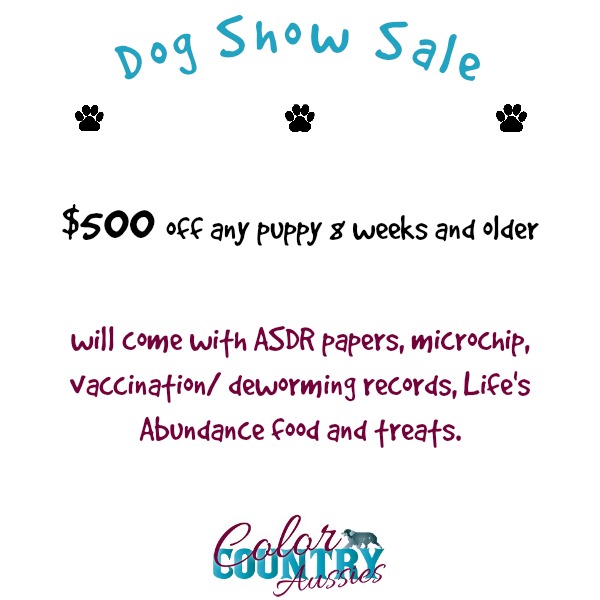
What Is a Conformation?
The term “conformation” can be used in many capacities. Conformation shows are a chance for breeders to display their purebred dogs, more commonly known as a “dog show”. Dogs are judged based on their potential to produce future generations which conform to the traditional appearance of the breed, or the breed standard. Secondly, the word conformation may be used as a description of body structure and general appearance. A dog is considered to have a good conformation if they closely resemble the breed standard. Each breed has different traits which are ideal and desired in future offspring.
Color Country Aussies believes in honoring and maintaining the Australian Shepherd tradition of excellence. Pure bloodlines which exemplify the breed standard are found in each dog we produce. Because of this, our Aussies continually shine in the show ring with their strong conformation and distinction.
GENERAL APPEARANCE
The Australian Shepherd should be a well balanced dog, wether its a Standard, Miniature or Toy. An Aussie is attentive and animated, showing strength and stamina combined with unusual agility. An identifying characteristic is his a docked bobtail. In each sex, masculinity or femininity is well defined. Bone is moderate and clean with coarseness, heaviness or lightness being undesirable.
CHARACTER
The Australian Shepherd is intelligent, primarily a working dog of strong herding and loyal instincts. Aussies are an exceptional companion. The Standard, Mini, and Toy Aussies are versatile and easily trained, performing their assigned tasks with great style and enthusiasm. The Australian Shepherds tend to be more shy and reserved with strangers but warm up with trust. Although an aggressive, authoritative worker, viciousness toward people or animals is intolerable.
HEAD
The head is clean cut, strong and dry. Overall size should be in proportion to the body. The muzzle is equal in length or slightly shorter than the back skull. Viewed from the side the topline of the back skull and muzzle form parallel planes, divided by a moderate, well-defined stop. The muzzle tapers little from base to nose and is rounded at the tip. Expression – Showing attentiveness and intelligence, alert and eager. Gaze should be keen but friendly. Eyes are brown, blue, amber or any variation or combination thereof, including flecks and marbling. Almond shaped, not protruding nor sunken. The blue merles and blacks have black pigmentation on eye rims. The red merles and reds have liver (brown) pigmentation on eye rims. Ears are triangular, of moderate size and leather, set high on the head. At full attention they break forward and over, or to the side as a rose ear. Prick ears and hanging ears are severe faults. Skull – Top flat to slightly domed. It may show a slight occipital protuberance. Length and width are equal. Moderate well-defined stop. Muzzle tapers little from base to nose and is rounded at the tip. Nose – Blue merles and blacks have black pigmentation on the nose (and lips). Red merles and reds have liver (brown) pigmentation on the nose (and lips). On the merles it is permissible to have small pink spots; however, they should not exceed 25 percent of the nose on dogs over one year of age, which is a serious fault. Dudley nose over 1 year of age is a Disqualification. Teeth– A full complement of strong white teeth should meet in a scissors bite or may meet in a level bite. Disqualifications – Undershot. Overshot greater than 1/8 inch. Loss of contact caused by short center incisors in an otherwise correct bite shall not be judged undershot. Teeth broken or missing by accident shall not be penalized.
NECK AND BODY
The neck is firm, clean and in proportion to the body. It is of medium length and slightly arched at the
crest, setting well into the shoulders. The body is firm and muscular. The topline appears level at a natural four-square stance. The chest is deep and strong with ribs well-sprung. The loin is strong and broad when viewed from the top. The bottom line carries well back with a moderate tuck-up. The croup is moderately sloping, the ideal being thirty (30) degrees from the horizontal. Tail is straight, not to exceed three (3) inches, natural bobbed or docked. We do allow non docked dogs to accomodate our foreign breeders, as some countries do not allow docking of tails. We also recognize that some people choose not to dock for personal reasons.
FOREQUARTERS
The shoulder blades (scapulae) are long and flat, close set at the withers, approximately two fingers width at a natural stance and are well laid back at an angle approximating forty-five (45) degrees to the ground. The upper arm (humerus) is attached at an approximate right angle to the shoulder line with forelegs dropping straight, perpendicular to the ground. The elbow joint is equidistant from the ground to the withers. The legs are straight and powerful. Pasterns are short, thick and strong, but still flexible, showing a slight angle when viewed from the side. Feet are oval shaped, compact, with close-knit, well-arched toes. Pads are thick and resilient; nails short and strong. Dewclaws may be removed.
HINDQUARTERS
Strong and muscular. Width of hindquarters approximately equal to the width of the forequarters at the shoulders. The angulation of the pelvis and the upper thigh (femur) corresponds to the angulation of the shoulder blade and upper arm forming an approximate right angle. Stifles are clearly defined, hock joints moderately bent. The metatarsi are short, perpendicular to the ground and parallel to each other when viewed from the rear. Feet are oval shaped, compact, with close-knit, well-arched toes. Pads are thick and resilient; nails short and strong. Rear dewclaws are removed.
to find more information visit https://www.americanstockdog.org/index.php?page=breeds







